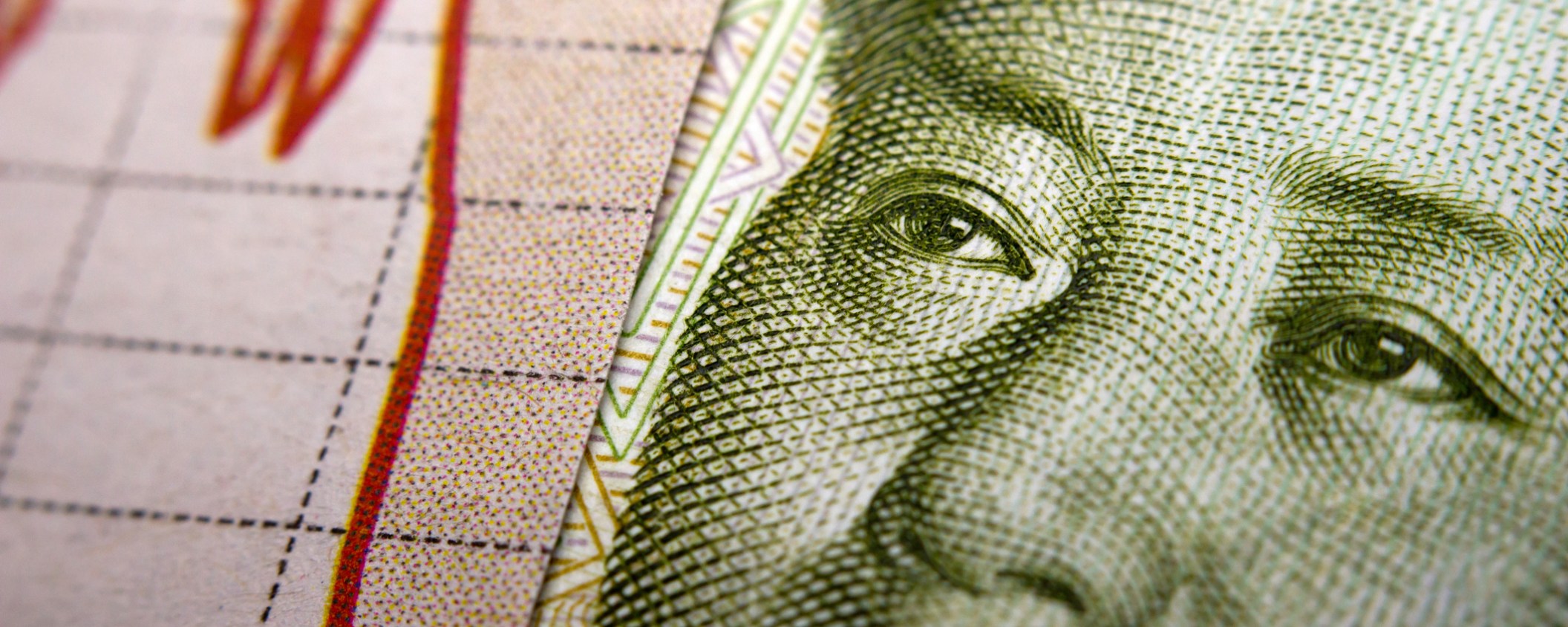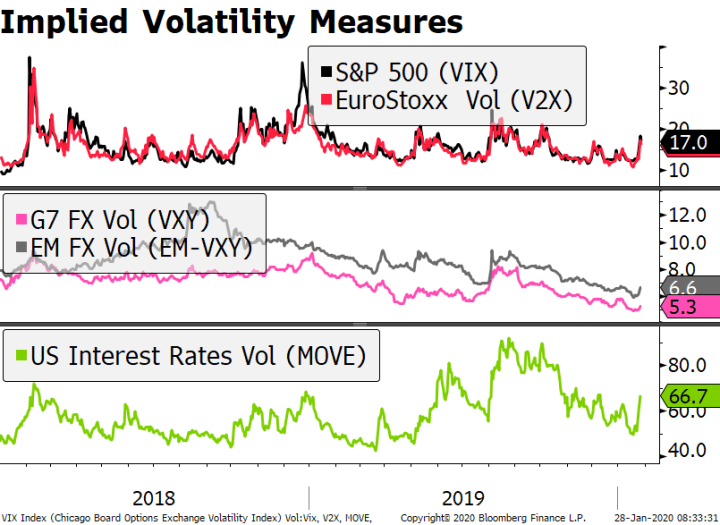The virus news stream out of Europe has improved a bit The US is already taking about the next relief bill; the Fed continues to roll out measures to address dollar funding issues ADP and ISM manufacturing PMI are the US data highlights Regulators across Europe are asking banks to stop paying dividends; eurozone and UK reported final manufacturing PMIs Japan Q1 Tankan report was released; BOJ tweaked its bond buying program for April RBA minutes were released; Korea reported weak March trade data The dollar is broadly firmer against the majors as global equities sink. Nokkie and yen are outperforming, while Loonie and Stockie are underperforming. EM currencies are broadly weaker. TWD and CNY are outperforming, while HUF and MXN are underperforming. MSCI Asia
Topics:
Win Thin considers the following as important: 5.) Brown Brothers Harriman, 5) Global Macro, Articles, Daily News, Featured, newsletter
This could be interesting, too:
Nachrichten Ticker - www.finanzen.ch writes Die Performance der Kryptowährungen in KW 9: Das hat sich bei Bitcoin, Ether & Co. getan
Nachrichten Ticker - www.finanzen.ch writes Wer verbirgt sich hinter der Ethereum-Technologie?
Martin Hartmann writes Eine Analyse nach den Lehren von Milton Friedman
Marc Chandler writes March 2025 Monthly
- The virus news stream out of Europe has improved a bit
- The US is already taking about the next relief bill; the Fed continues to roll out measures to address dollar funding issues
- ADP and ISM manufacturing PMI are the US data highlights
- Regulators across Europe are asking banks to stop paying dividends; eurozone and UK reported final manufacturing PMIs
- Japan Q1 Tankan report was released; BOJ tweaked its bond buying program for April
- RBA minutes were released; Korea reported weak March trade data
 The dollar is broadly firmer against the majors as global equities sink. Nokkie and yen are outperforming, while Loonie and Stockie are underperforming. EM currencies are broadly weaker. TWD and CNY are outperforming, while HUF and MXN are underperforming. MSCI Asia Pacific was down 2.0% on the day, with the Nikkei falling 4.5%. MSCI EM is down 1.8% so far today, with the Shanghai Composite falling 0.6%. Euro Stoxx 600 is down 2.8% near midday, while US futures are pointing to a lower open. 10-year UST yields are down 6 bp at 0.61%, while the 3-month to 10-year spread is down 3 bp to stand at +58 bp. Commodity prices are mostly lower, with Brent oil down 2.8%, copper down 2.3%, and gold up 1.0%.
The dollar is broadly firmer against the majors as global equities sink. Nokkie and yen are outperforming, while Loonie and Stockie are underperforming. EM currencies are broadly weaker. TWD and CNY are outperforming, while HUF and MXN are underperforming. MSCI Asia Pacific was down 2.0% on the day, with the Nikkei falling 4.5%. MSCI EM is down 1.8% so far today, with the Shanghai Composite falling 0.6%. Euro Stoxx 600 is down 2.8% near midday, while US futures are pointing to a lower open. 10-year UST yields are down 6 bp at 0.61%, while the 3-month to 10-year spread is down 3 bp to stand at +58 bp. Commodity prices are mostly lower, with Brent oil down 2.8%, copper down 2.3%, and gold up 1.0%.
The virus news stream out of Europe has improved a bit. It appears that the situation in Italy continues to stabilize, with the head of the public health institute confirming that the country had “reached a plateau in the contagion phase.” That said, there are rising concerns about social stability, especially in the country’s southern regions. Italy has a total of 106K confirmed cases and 12.5K deaths from the virus. The death count continues to rise in Spain, but the trend there also seems to be improving.
US credit markets have been on a gradual improving trend, at least until yesterday. Both investment grade and non-energy high yields major indices have recouped about one third of their recent losses. This was in large part due to the extreme measures by the US authorities from credit facilities to liquidity injections. The high yield energy sector has also trended higher along with the broad improvement in risk appetite over the last few sessions but is down nearly 40% this year.
The dollar remains resilient. DXY has retraced about a third of last week’s drop and continues to move off those lows. The euro has retraced nearly half of its recent gains and a break below the $1.09 area would signal deeper losses. Sterling has held up better, which has pushed the EUR/GBP cross down. Break of the .8745 area would set up a test of the February low near .8277. USD/JPY remains stuck near 108.
AMERICAS
The US is already taking about the next relief bill. President Trump called for $2 trln of infrastructure spending to be included. His tone has become much more somber this week, as he warned of “a painful two weeks” ahead. He added that restrictions on meeting and movement may last “long into the future.”
The Fed continues to roll out measures to address dollar funding issues. Yesterday, it introduced a repo program for foreign and international monetary authorities (FIMA) that allows foreign central banks to access dollars by posting US Treasuries already held at the Fed as collateral. This will be especially beneficial to EMs suffering from dollar funding issues and is another way for the Fed to address the structural shortage of dollars globally. We don’t think these new operations will have much lasting impact on exchange rates since by definition, the repos will be unwound and any dollars accessed will eventually have to be repaid. Just to be clear, this is slightly different from the existing dollar swap lines. Those line involve the central banks swapping their currencies for dollars, with the swap to be unwound later.
ADP jobs data will be reported today, with private sector jobs expected at -150k. This will be another clue for the March jobs data Friday, where consensus currently sees -100k vs. +273k in February. Note initial jobless claims were 282k for the BLS survey week containing the 12th of the month, the highest since September 2017 and followed by the record high 3.283 mln reading last week. Another 3.5 mln jump in claims is expected for the following week and so whatever the March reading is for nonfarm payrolls, it’s clear that April will be significantly worse.
March ISM manufacturing PMI will be also reported today and is expected to fall to 44.5 from 50.1 in February. The employment component will be the next and final clue for Friday’s jobs data. Note that March Chicago PMI reported yesterday came in at 47.8 vs. 40.0 expected and 49.0 in February. That survey was conducted between March 2-16 and so it was still the early days of the crisis. March auto sales (12.0 mln annualized expected) and February construction spending (0.6% m/m expected) will be reported. Markit Canada manufacturing PMI will also be reported today.
EUROPE/MIDDLE EAST/AFRICA
Regulators across Europe are asking banks to stop paying dividends, hurting stock prices in the sector. Today, it was the UK’s turn. Reports suggest the top five UK banks were planning to pay out GBP7.5 bln in dividends over the next two months. The sector is underperforming on the day and has taken a heavy hit this year given flatter yield curves and other risk factors such as NPL risks. The EuroStoxx banking sub-index is down 45% this year and UK banks down 39%.
Final UK manufacturing PMI was reported. It fell slightly to 47.8 vs. 47.0 expected and 48.0 flash reading. This will be followed by services and composite Friday, which are expected to fall about a point from the flash readings of 35.7 and 37.1, respectively. The $1.25 area is proving hard to break for cable. That’s the 62% retracement objective for the March drop. Sterling bulls may be a little nervous after the Fitch downgrade, as more cuts are surely coming. Also, many are likely bracing for a likely spike in virus cases as testing picks up after lagging previously.
Final eurozone manufacturing PMI readings were reported. Headline eurozone reading fell to 44.5 vs. 44.6 expected and 44.8 flash reading. Germany worsened from the flash readings to 45.4, while France improved to 43.2. Spain and Italy both fell sharply from February to 45.7 and 40.3, respectively. Final services PMI readings will be reported Friday. Of note, Germany reported firm February retail sales. Sales rose 1.2% m/m vs. 0.1% expected and a revised 1.0% (was 0.9% in January.
The Turkish central bank initiated a new set of emergency measures to mitigate the impact of the virus. Officials will frontload its bond purchases, widen the range of accepted collateral for its operations, and said they could revise the original purchase limits. These measures may help liquidity in the short term, but the additional lira stimulus will likely add to the currency’s depreciation trend. CDS prices are widening, and we see no respite for Turkish asset prices in the near term, bar a decisive and broad-base shift in global risk appetite.
President Trump’s attempts to pressure Russia and Saudi Arabia into supporting oil prices have had little impact. Today, he claimed that the two OPEC+ nations would meet and that the US would join the talks at an appropriate time. We might expect some comforting diplomatic words from these leaders expressing their concern, but we still don’t see any reason to believe there will be material supply cuts in the foreseeable future. Oil futures are down across the board, but more in the shorter contracts, hence further widening the severe contango we are seeing across the curve.
ASIA
Japan Q1 Tankan report was released. Large manufacturers index came at -8 vs. -10 expected and 0 in Q4, while small manufacturers index came in at -15 vs. -20 expected and -9 in Q4. Large manufacturers outlook came in at 11 vs. -15 expected and 0 in Q4, while small manufacturers outlook came in at -29 vs. -25 expected and -12 in Q4. Non-manufacturing readings also worsened, while large firm’s capex slowed to 1.8%, close to expectations but down from 6.8% in Q4. While the impact of the coronavirus is already being felt, the Japanese economy will come under even more stress as social distancing picks up in Q2.
The Bank of Japan tweaked its bond buying plans for April. Of note, it increased the frequency and amounts of purchases for debt with 5- to 10-year maturities. It can now buy as much as JPY2.5 trln this month compared to JPY2 trln in March. The news comes a day after the government unveiled a huge stimulus plan that will reportedly boost debt issuance by JPY16 trln. As such, the BOJ is sending a signal that it will continue its efforts to keep bond yields down in face of increased supply.
Reserve Bank of Australia minutes were released. At that meeting, the bank cut rates 25 bp and started QE with yield curve control. The minutes warned of rising job losses and a “very material” contraction in the economy. Officials noted that the policy rate was now at its effective lower bound and would remain low for an extended period, adding that there was no appetite for negative rates. AUD retraced nearly two thirds of its March losses but ran out of steam near the 0.62 area and feels heavy now.
Korea reported weak March trade data. Exports contracted -0.2% y/y vs. +1.6% expected, while imports contracted -0.3% y/y vs. +0.7% expected. Of note, exports to China fell -5.8% y/y and shipments of semiconductors fell -2.7% y/y. There were more working days in March this year compared to 2019 and so if data were adjusted for this, the readings would be even worse. This is an important bellwether for the region and suggests little relief ahead.
Tags: Articles,Daily News,Featured,newsletter







